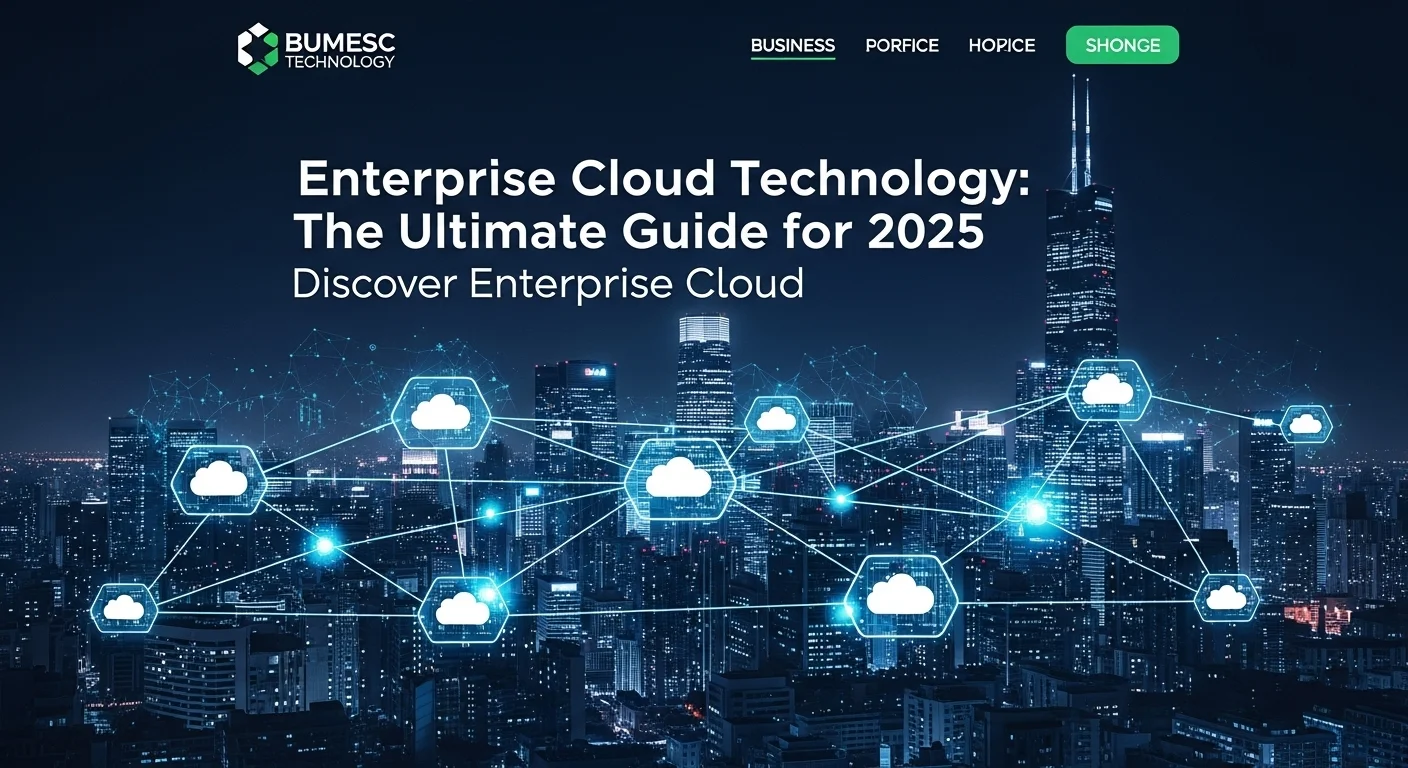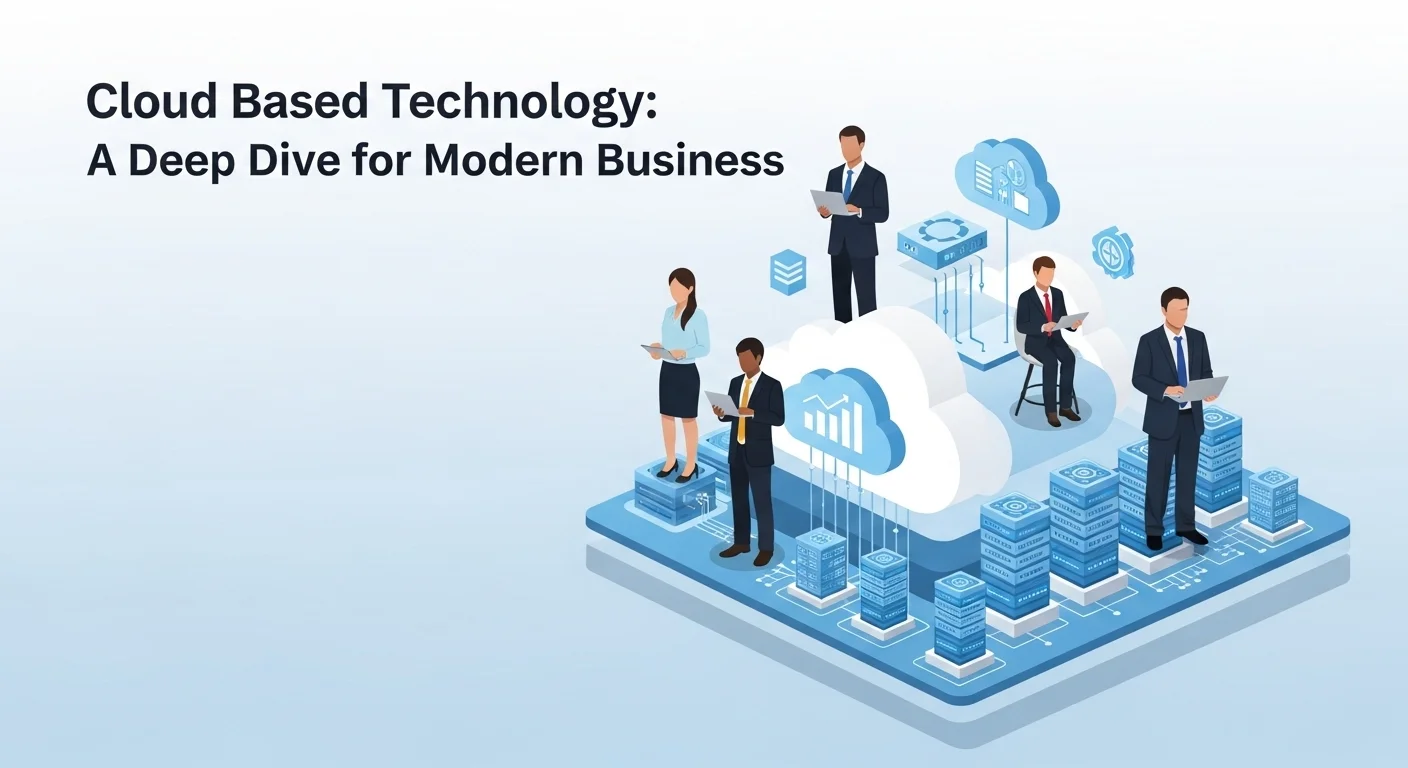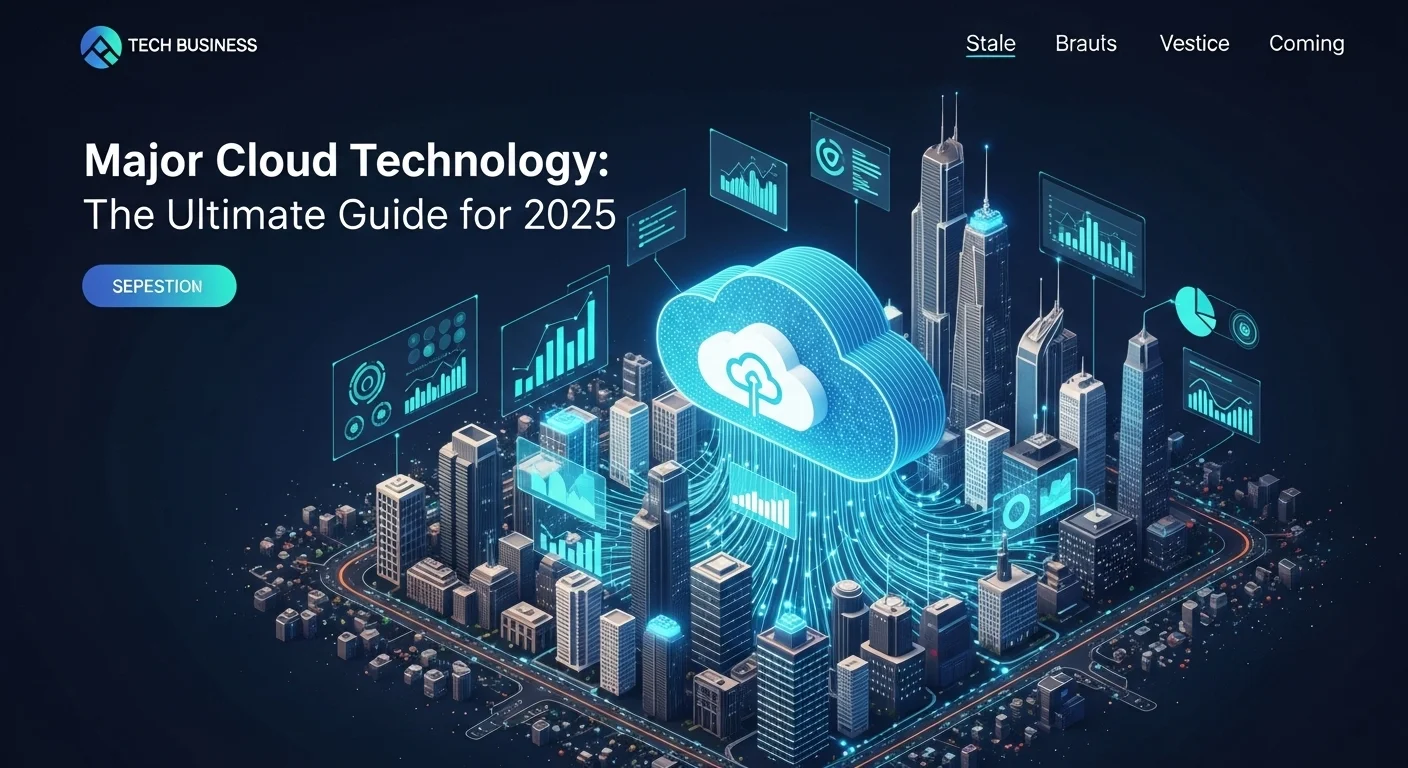Your Practical Guide to Enterprise Cloud: Unlocking Business Growth

Executive Summary
In my years as a cloud strategist, I've seen firsthand how enterprise cloud technology has gone from a technical buzzword to the absolute engine of business innovation and efficiency. This guide is my way of cutting through the jargon and giving you a real-world look into the enterprise cloud. We'll start with the basics: what it is, how it's different from the cloud services you might use every day, and why it's so vital in today's market. I'll share insights on the incredible benefits I've helped companies unlock, from scaling on a dime and slashing costs to bulletproofing their disaster recovery plans. We'll walk through the solutions offered by the big players, putting a special lens on Google Enterprise Cloud, and tackle the all-important topic of security, looking at frameworks and tools like Prisma Cloud Enterprise that keep your data safe. Think of this as your personal roadmap to understanding how the right cloud strategy can open up new worlds of productivity and give you a powerful competitive edge.
Table of Contents
Table of Contents
- What Exactly is Enterprise Cloud?
- The Core Concepts Explained Simply
- Business Applications and Real-World Benefits
- The Truth About Enterprise Cloud Security
What is Enterprise Cloud and why is it important in Technology?
I remember when 'the cloud' was a term people threw around in meetings, often without a clear meaning. But when you add the word 'enterprise,' it transforms from a fuzzy concept into a powerful business strategy. In simple terms, Enterprise Cloud is a robust suite of cloud services—think infrastructure, platforms, and software—built specifically to handle the heavy-lifting required by large organizations. [9] It's not like your personal cloud storage. This is the industrial-strength version, engineered for top-tier performance, ironclad security, and the ability to scale up for mission-critical work. [2, 9] This approach usually mixes public, private, and hybrid cloud services to perfectly fit a company's unique operational, security, and budget needs. [4] The magic of enterprise cloud computing is how it flips the old IT model on its head. Instead of buying and maintaining mountains of physical hardware (a huge capital expense), companies can tap into a flexible, pay-as-you-go model. [2, 7] This means getting the computing power, data storage, and advanced applications you need, right when you need them, over the internet. This agility is what allows a business to truly thrive in our fast-moving digital world. [2] Believe me, this isn't just another piece of tech; it's the launchpad for digital transformation, innovation, and a serious competitive advantage. [6, 10]
The Fundamental Concepts of Enterprise Cloud Computing
At its core, enterprise cloud computing is about getting your IT resources delivered as a service, ready to use over a network. [3] It’s typically broken down into three main flavors: Infrastructure as a Service (IaaS), Platform as a Service (PaaS), and Software as a Service (SaaS). [10, 11] Think of it like building a house. IaaS gives you the land and raw materials (virtual servers, storage, networking). [11] PaaS gives you the foundation and framework, letting your developers build and run applications without worrying about the underlying construction. [34] SaaS is the fully furnished, move-in-ready house (like a CRM or email system). [10] Businesses rarely stick to just one. For instance, I've seen companies use IaaS from a provider like Google Enterprise Cloud to run their custom apps while using a SaaS for their email. This mix-and-match flexibility is a hallmark of enterprise solutions. The deployment models add another layer of choice. A private cloud is your own exclusive fortress, offering maximum control. [3] A public cloud is like a massive, shared industrial park with endless resources and cost benefits. [3] And a hybrid cloud lets you connect the two, giving you the best of both worlds—keeping sensitive data in your fortress while using the public park for everything else. [9] This powerful combination of service and deployment is what makes the enterprise and cloud computing relationship so transformative.
Business Applications and Transformative Benefits
The impact of enterprise cloud is everywhere, across every industry you can imagine. [4, 9] In healthcare, it's used to securely manage patient records and power telemedicine. [9] In retail, it runs the e-commerce sites that handle massive holiday traffic spikes and analyzes customer behavior to create personalized shopping experiences. [9] The reasons for this massive shift are clear and compelling. Scalability and Flexibility: This is a big one. The ability to instantly scale resources up or down is a game-changer. [6, 8] It lets businesses react to market changes in an instant, without waiting weeks to order and set up new servers. [2] It also makes supporting a global, remote workforce a breeze. [2] Cost-Efficiency: Shifting to the cloud dramatically cuts down on the money spent on physical hardware and data centers. [7] The pay-for-what-you-use model optimizes your budget beautifully. [11] Plus, the provider handles all the maintenance and upgrades, freeing up your IT team to focus on more important things. [2] Better Collaboration: Cloud platforms become a central meeting point for data and apps, allowing teams from across the globe to work together seamlessly. [9] It’s a huge boost for productivity. Disaster Recovery: I’ve seen cloud-based disaster recovery save a company's skin. By replicating data across different locations, your business can keep running even if one location goes down, with automated systems kicking in to minimize any interruption. [2, 4] Innovation on Demand: The cloud gives you access to incredible tools like AI, machine learning, and big data analytics. It becomes a playground for innovation, letting you test new ideas and launch apps faster than ever before. [7, 9]
The Critical Role of Enterprise Cloud Security
Let's be direct: as you move more of your valuable business operations to the cloud, security has to be your top priority. [3] A single breach can be catastrophic. [5] Because of this, enterprise cloud security is a specialized field focused on protecting your cloud environment with the right policies, technology, and controls. [14, 18] It all starts with understanding the 'shared responsibility model'. [14, 15] Here's the simple version: your cloud provider (like Google Cloud) is responsible for securing the cloud itself—their physical data centers, servers, and networks. [15] You are responsible for security *in* the cloud—protecting your data, applications, and who has access to them. [14] A lot of security issues I’ve seen stem from a simple misunderstanding of this line. [14] A layered approach is the only way to go. This means strong identity management, encrypting your data, and constantly monitoring for threats. [23] This is where specialized platforms like Prisma Cloud Enterprise from Palo Alto Networks become so valuable. [16] As a Cloud-Native Application Protection Platform (CNAPP), it gives you a single view to manage security from the moment code is written until it's running live. [16, 27] It can find vulnerabilities, check for compliance, and spot threats across your entire cloud setup, helping your security and development teams work together. [16, 27] Tools like Prisma Cloud Enterprise are essential for taming the complexity of modern enterprise cloud security and keeping your enterprise and cloud computing ecosystem safe and sound.

Complete guide to Enterprise Cloud in Technology and Business Solutions
Moving to the enterprise cloud isn't just about flipping a switch; it’s a strategic journey that needs to be woven into your business goals. [13] From my experience, a successful cloud adoption comes down to smart planning, careful execution, and smart ongoing management. This part of the guide is your practical roadmap. We'll dive into how to pick the right structure, compare the leading providers, and implement security that lets you sleep at night, empowering you to get the most out of enterprise cloud computing.
Choosing the Right Enterprise Cloud Architecture
The foundation of your entire cloud strategy is picking the right architecture. This choice depends entirely on your specific needs for performance, security, regulations, and budget. Here are the main options: [3] Public Cloud: This is where services are delivered over the internet and shared by many organizations. [3] Think of providers like Amazon Web Services (AWS), Microsoft Azure, and Google Enterprise Cloud. They offer a huge menu of services you pay for as you go. The public cloud is perfect for workloads that have big swings in demand, for development and testing, or for applications that aren't handling super-sensitive data. It's incredibly scalable and cost-effective. [11] Private Cloud: A private cloud is your own personal cloud infrastructure, dedicated just to your organization. [3] You can host it yourself or have a third party manage it. This gives you the ultimate control and security, making it a go-to for companies in finance or healthcare with strict data rules. [6] The trade-off is a higher upfront cost and more hands-on management. Hybrid Cloud: Just like it sounds, a hybrid cloud blends public and private clouds, letting them talk to each other. [9] This gives you the best of both worlds. I often recommend this approach because you can keep your most sensitive data in your secure private cloud while using the massive, affordable resources of the public cloud for other tasks or to handle unexpected traffic surges. [6, 9] Its flexibility is why it’s become so popular. Multi-Cloud: A multi-cloud strategy means you're using services from more than one public cloud provider. [5] For example, you might use Google Enterprise Cloud for its amazing data analytics and machine learning tools, while using AWS for its wide range of basic infrastructure services. [5] This helps you avoid being locked into one vendor and lets you pick the best tool for each job. [29] The challenge? It can get complex to manage, which is why a unified enterprise cloud security platform is so important to keep everything consistent.
Technical Implementation and Migration Strategies
Once you've chosen an architecture, it's time to get technical. This usually starts with moving your existing applications and data to the cloud. A solid plan is key to avoiding headaches. [3] We often talk about the '6 Rs' of migration, but let's simplify them: Rehosting (Lift and Shift): You basically copy and paste your applications to the cloud with very few changes. [19] It's fast, but you might not get all the cloud benefits. Replatforming (Lift and Reshape): Here, you make a few tweaks to your app to take better advantage of the cloud, like switching to a managed database service. It’s a nice middle ground. Repurchasing (Drop and Shop): This means ditching an old application and moving to a ready-made SaaS solution that does the same thing, like swapping an on-premise CRM for a cloud-based one. Refactoring/Rearchitecting: This is the big one. You rebuild your application to be fully 'cloud-native.' [19] It’s the most work, but it delivers the biggest payoff in performance, scalability, and cost savings. Retiring: You simply shut down applications you don't need anymore. You'd be surprised how many of these are often hiding in plain sight. Retaining: Sometimes, it makes sense to leave things where they are, either for legal reasons, because of technical constraints, or because it's just not worth the cost to move. The right strategy really depends on the application itself, so starting with a full review of your current IT setup is a must. [19]
Comparing Major Providers and Leveraging Key Resources
The enterprise cloud market is led by a few heavyweights, and each has its own personality. Google Enterprise Cloud is, in my experience, the leader when it comes to data analytics, machine learning (AI/ML), and managing containers with Kubernetes (which Google invented). If your business is driven by data and innovation, it's a fantastic choice. AWS is the market veteran with the largest and most mature set of services for almost any use case you can dream up. Microsoft Azure has a huge advantage with companies already using Microsoft products like Office 365, and its hybrid cloud solutions are top-notch. [7] When choosing, you have to weigh things like services, pricing, and support. But the journey of enterprise and cloud computing doesn't stop after you pick a provider. It needs constant care. This is where tools become your best friend. For example, Prisma Cloud Enterprise is built to give you a single security dashboard across multiple clouds like AWS, Azure, and Google Cloud. [25] It takes the headache out of multi-cloud security by managing your security posture, finding threats, and ensuring compliance from one place. [16, 25] This lets you confidently use the best services from each provider without creating security gaps, ensuring a solid enterprise cloud security strategy.

Tips and strategies for Enterprise Cloud to improve your Technology experience
Getting on the cloud isn't a one-and-done deal; it's a continuous process of tuning and improving. [31] To really get the most bang for your buck, you need to go beyond the basics. This section is all about actionable tips I've learned over the years to help you manage costs, tighten security, and future-proof your cloud setup. By putting these strategies into practice, you can make sure your cloud is not just powerful, but also efficient, secure, and ready for what's next.
Mastering Cloud Cost Management (FinOps)
People move to the cloud to save money, but I’ve seen costs spiral out of control without proper oversight. [5, 33] This is where FinOps comes in—it’s a mindset of bringing financial discipline to your cloud spending. Here are my go-to strategies: Tag Everything: Create a clear tagging policy for every single resource in your cloud. Think of tags as labels that tell you which project, department, or team owns a resource. This makes it easy to see who is spending what and hold them accountable. Use the Free Tools: Your cloud provider gives you powerful cost management tools for free, like AWS Cost Explorer, Azure Cost Management, or the dashboards in Google Enterprise Cloud. Use them! They show you exactly where your money is going and help you spot waste. [13] Right-Size and Automate Shutdowns: Constantly check if you're using all the power you're paying for. If not, 'right-size' your instances to match what you actually need. [13] A huge money-saver is to set up automated scripts to turn off development and test environments overnight and on weekends. You're not paying for what you don't use. Commit for Discounts: If you have workloads that run consistently, commit to them with Reserved Instances (RIs) or Savings Plans. [13] You can get massive discounts compared to on-demand pricing just by committing for a year or three. These simple habits will give you control over your cloud bill and ensure your investment in enterprise cloud computing pays off handsomely.
Advanced Enterprise Cloud Security Strategies
Basic security is essential, but a truly mature cloud strategy uses advanced, proactive measures to stay ahead of threats. [15] The aim is to build a security posture that can adapt and fight back. Adopt a Zero-Trust Mindset: The old idea of a secure network 'perimeter' is dead in the cloud. A Zero-Trust model works on a simple but powerful rule: 'never trust, always verify.' It demands strict proof of identity from every person and device trying to access anything, no matter where they are. [36] This dramatically shrinks the area an attacker can target. Automate Your Defenses: You can't manually keep up with the speed of the cloud. [18] Use automated tools to constantly scan for compliance issues and security threats. This is a huge strength of platforms like Prisma Cloud Enterprise. [27] It can automatically find misconfigurations, vulnerabilities, and weird activity across your entire cloud environment, giving you instant alerts and sometimes even fixing the problem for you. [16] This kind of automation is non-negotiable for maintaining strong enterprise cloud security at scale. Make Security Everyone's Job (DevSecOps): Weave security into every step of your development process. This is called DevSecOps, and it means scanning code for flaws before it ever goes live and putting security experts right inside your development teams. By 'shifting left,' you catch problems early when they're much easier and cheaper to fix. For a great resource on security frameworks, I always recommend checking out the NIST Cybersecurity Framework.
Optimizing Operations and Preparing for the Future
An optimized cloud environment runs smoothly, performs beautifully, and is ready for whatever comes next. Implement Deep Monitoring and Observability: Go beyond simple 'is it on or off?' checks. Set up a monitoring strategy that gives you real insight into how your applications and infrastructure are performing. [31] Track things like response times, error rates, and resource usage to spot problems before your users do. [31] Observability takes it a step further, giving you the context to understand *why* something is going wrong. Automate with Infrastructure as Code (IaC): Automate everything you can, from setting up servers to deploying code. [32] Using IaC tools like Terraform or Google Cloud Deployment Manager lets you define your entire infrastructure in code files. This makes everything consistent, repeatable, and far less prone to human error. Keep an Eye on the Horizon: The world of enterprise and cloud computing is always changing. Stay curious about what’s next, like serverless computing, edge computing, and the deeper integration of AI/ML into cloud services. [36] Leaders like Google Enterprise Cloud are constantly pushing the envelope with new services. [36] By building a flexible, automated, and secure foundation today, you'll be in the perfect position to embrace these future technologies and keep your competitive edge.
Expert Reviews & Testimonials
Sarah Johnson, Business Owner ⭐⭐⭐⭐
This was really helpful. As a business owner, the jargon can be overwhelming, but this article broke down Enterprise Cloud in a way that actually made sense. I would have loved a few more small business examples, but it's a great starting point.
Mike Chen, IT Consultant ⭐⭐⭐⭐
Solid overview of Enterprise Cloud. I appreciate the practical take on migration strategies and the comparison between providers. It confirmed a few things for me and gave me some new points to consider for my clients. A good, useful read.
Emma Davis, Tech Expert ⭐⭐⭐⭐⭐
Fantastic article! As someone deep in this field, I can say this is one of the most comprehensive and clearly-written guides on Enterprise Cloud I've come across. It perfectly balances high-level strategy with the essential technical details. Excellent job.



